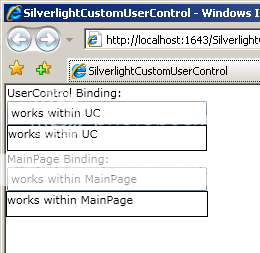Silverlight UserControl自定义属性绑定
在Silverlight UserControls中实现自定义属性的正确方法是什么?
Silverlight中的每个“Page”在技术上都是UserControl(它们派生自UserControl类)。当我在这里说UserControl时,我指的是一个自定义UserControl,它将在许多不同场景中的许多不同页面中使用(类似于ASP.NET UserControl)。
我希望Custom UserControl支持Binding,而不依赖于它绑定的Property的名称,始终保持相同。相反,我希望UserControl本身具有UserControl中的Controls绑定到的属性,UserControl外部的ViewModels也绑定到该属性。 (请参阅下面的例子)
UserControl中的绑定工作,MainPage中的绑定工作,我在MainPage和UserControl之间设置的绑定不起作用。特别是这一行:
<myUserControls:MyCustomUserControl x:Name="MyCustomControl2"
SelectedText="{Binding MainPageSelectedText, Mode=TwoWay}"
Width="200" Height="50" />
示例输出:

MainPage.xaml中
<UserControl x:Class="SilverlightCustomUserControl.MainPage"
xmlns="http://schemas.microsoft.com/winfx/2006/xaml/presentation"
xmlns:x="http://schemas.microsoft.com/winfx/2006/xaml"
xmlns:d="http://schemas.microsoft.com/expression/blend/2008"
xmlns:mc="http://schemas.openxmlformats.org/markup-compatibility/2006"
xmlns:myUserControls="clr-namespace:SilverlightCustomUserControl"
mc:Ignorable="d" d:DesignWidth="640" d:DesignHeight="480"
DataContext="{Binding RelativeSource={RelativeSource Self}}">
<Canvas x:Name="LayoutRoot">
<StackPanel Orientation="Vertical">
<TextBlock Text="UserControl Binding:" Width="200"></TextBlock>
<myUserControls:MyCustomUserControl x:Name="MyCustomControl2" SelectedText="{Binding MainPageSelectedText, Mode=TwoWay}" Width="200" Height="50" />
<TextBlock Text="MainPage Binding:" Width="200"></TextBlock>
<TextBox Text="{Binding MainPageSelectedText, Mode=TwoWay}" Width="200"></TextBox>
<Border BorderBrush="Black" BorderThickness="1">
<TextBlock Text="{Binding MainPageSelectedText}" Width="200" Height="24"></TextBlock>
</Border>
</StackPanel>
</Canvas>
</UserControl>
MainPage.xaml.cs中
namespace SilverlightCustomUserControl
{
public partial class MainPage : UserControl, INotifyPropertyChanged
{
//NOTE: would probably be in a ViewModel
public string MainPageSelectedText
{
get { return _MainPageSelectedText; }
set
{
string myValue = value ?? String.Empty;
if (_MainPageSelectedText != myValue)
{
_MainPageSelectedText = value;
OnPropertyChanged("MainPageSelectedText");
}
}
}
private string _MainPageSelectedText;
public MainPage()
{
InitializeComponent();
}
#region INotifyPropertyChanged Members
public event PropertyChangedEventHandler PropertyChanged;
protected virtual void OnPropertyChanged(string name)
{
PropertyChangedEventHandler ph = this.PropertyChanged;
if (ph != null)
ph(this, new PropertyChangedEventArgs(name));
}
#endregion
}
}
MyCustomUserControl.xaml
<UserControl
x:Class="SilverlightCustomUserControl.MyCustomUserControl"
xmlns="http://schemas.microsoft.com/winfx/2006/xaml/presentation"
xmlns:x="http://schemas.microsoft.com/winfx/2006/xaml"
xmlns:d="http://schemas.microsoft.com/expression/blend/2008"
xmlns:mc="http://schemas.openxmlformats.org/markup-compatibility/2006"
DataContext="{Binding RelativeSource={RelativeSource Self}}">
<Grid>
<StackPanel>
<TextBox Text="{Binding SelectedText, Mode=TwoWay}" />
<Border BorderBrush="Black" BorderThickness="1">
<TextBlock Text="{Binding SelectedText}" Height="24"></TextBlock>
</Border>
</StackPanel>
</Grid>
</UserControl>
MyCustomUserControl.xaml.cs
namespace SilverlightCustomUserControl
{
public partial class MyCustomUserControl : UserControl
{
public string SelectedText
{
get { return (string)GetValue(SelectedTextProperty); }
set { SetValue(SelectedTextProperty, value); }
}
public static readonly DependencyProperty SelectedTextProperty =
DependencyProperty.Register("SelectedText", typeof(string), typeof(MyCustomUserControl), new PropertyMetadata("", SelectedText_PropertyChangedCallback));
public MyCustomUserControl()
{
InitializeComponent();
}
private static void SelectedText_PropertyChangedCallback(DependencyObject d, DependencyPropertyChangedEventArgs e)
{
//empty
}
}
}
参考文献(我是如何做到这一点的):
使用DependencyPropertys: http://geekswithblogs.net/thibbard/archive/2008/04/22/wpf-custom-control-dependency-property-gotcha.aspx
使用DependencyPropertys,将x:Name添加到UserControl - 使用ElementName添加Binding,再次在PropertyChangedCallback方法中设置Custom属性: Setting Custom Properties in UserControl via DataBinding
不要使用自定义属性,依赖底层的datacontext名称(我不喜欢这个解决方案): wpf trouble using dependency properties in a UserControl
3 个答案:
答案 0 :(得分:7)
我理解它是你的控件没有从maim页面接收新值的原因是你正在设置控件的DataContext。如果还没有,那么控件的DataContext将从其父级继承,在这种情况下是主页面。
为了实现这一点,我删除了你的控件的DataContext设置,为每个控件添加了一个x:Name,并使用[name] .SetBinding方法在控件的构造函数中设置绑定。
我在ctor中进行了绑定,因为我无法找到将xaml中的声明性绑定的Source属性设置为Self的方法。即{Binding SelectedText,Mode = TwoWay,Source = [Self here some how] 2}。我确实尝试过使用RelativeSource = {RelativeSource Self}而没有任何快乐。
注意:所有这些都是SL3。
答案 1 :(得分:4)
问题是UserControl抛出了一个DataBinding错误(在调试时在Output窗口中可见)
因为UserControl的DataContext在其自己的xaml中被设置为“Self”,所以它在自己的上下文中寻找MainPageSelectedText(它没有在“MainPage”中寻找MainPageSelectedText,这可能是你认为它看起来的地方,因为当你在实际编写/查看“上下文”中的代码时)
通过在后面的代码中设置Binding,我能够“正常工作”。在后面的代码中设置绑定是将UserControl本身设置为绑定的“源”的唯一方法。但这仅在绑定为TwoWay时才有效。 OneWay绑定将破坏此代码。一个更好的解决方案是创建Silverlight Control ,而不是 UserControl 。
另见:
http://msdn.microsoft.com/en-us/library/cc278064%28VS.95%29.aspx
MyCustomUserControl.xaml
<UserControl
x:Class="SilverlightCustomUserControl.MyCustomUserControl"
xmlns="http://schemas.microsoft.com/winfx/2006/xaml/presentation"
xmlns:x="http://schemas.microsoft.com/winfx/2006/xaml"
xmlns:d="http://schemas.microsoft.com/expression/blend/2008"
xmlns:mc="http://schemas.openxmlformats.org/markup-compatibility/2006">
<Grid>
<StackPanel>
<TextBox x:Name="UserControlTextBox" />
<Border BorderBrush="Black" BorderThickness="1">
<TextBlock x:Name="UserControlTextBlock" Height="24"></TextBlock>
</Border>
</StackPanel>
</Grid>
</UserControl>
MyCustomUserControl.xaml.cs
namespace SilverlightCustomUserControl
{
public partial class MyCustomUserControl : UserControl
{
public string SelectedText
{
get { return (string)GetValue(SelectedTextProperty); }
set { SetValue(SelectedTextProperty, value); }
}
public static readonly DependencyProperty SelectedTextProperty =
DependencyProperty.Register("SelectedText", typeof(string), typeof(MyCustomUserControl), new PropertyMetadata("", SelectedText_PropertyChangedCallback));
public MyCustomUserControl()
{
InitializeComponent();
//SEE HERE
UserControlTextBox.SetBinding(TextBox.TextProperty, new Binding() { Source = this, Path = new PropertyPath("SelectedText"), Mode = BindingMode.TwoWay });
UserControlTextBlock.SetBinding(TextBlock.TextProperty, new Binding() { Source = this, Path = new PropertyPath("SelectedText") });
//SEE HERE
}
private static void SelectedText_PropertyChangedCallback(DependencyObject d, DependencyPropertyChangedEventArgs e)
{
//empty
}
}
}
答案 2 :(得分:0)
您可以通过为用户控件添加x:Name来设置xaml中的绑定,而不是将数据上下文绑定到self,然后在用户控件xaml中进行绑定:
<UserControl
x:Class="SilverlightCustomUserControl.MyCustomUserControl"
x:Name="myUserControl
xmlns="http://schemas.microsoft.com/winfx/2006/xaml/presentation"
xmlns:x="http://schemas.microsoft.com/winfx/2006/xaml"
xmlns:d="http://schemas.microsoft.com/expression/blend/2008"
xmlns:mc="http://schemas.openxmlformats.org/markup-compatibility/2006">
<Grid>
<StackPanel>
<TextBox Text="{Binding SelectedText, ElementName=myUserContol, Mode=TwoWay}" />
<Border BorderBrush="Black" BorderThickness="1">
<TextBlock Text="{Binding SelectedText,ElementName=myUserControl}" Height="24"></TextBlock>
</Border>
</StackPanel>
</Grid>
</UserControl>
- 我写了这段代码,但我无法理解我的错误
- 我无法从一个代码实例的列表中删除 None 值,但我可以在另一个实例中。为什么它适用于一个细分市场而不适用于另一个细分市场?
- 是否有可能使 loadstring 不可能等于打印?卢阿
- java中的random.expovariate()
- Appscript 通过会议在 Google 日历中发送电子邮件和创建活动
- 为什么我的 Onclick 箭头功能在 React 中不起作用?
- 在此代码中是否有使用“this”的替代方法?
- 在 SQL Server 和 PostgreSQL 上查询,我如何从第一个表获得第二个表的可视化
- 每千个数字得到
- 更新了城市边界 KML 文件的来源?